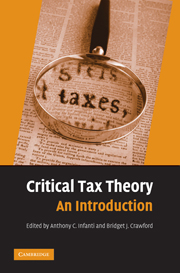Book contents
- Frontmatter
- Contents
- List of Illustrations
- List of Tables
- List of Contributors
- List of Common Abbreviations
- Introduction
- CHAPTER 1 FOUNDATIONS OF CRITICAL TAX THEORY
- CHAPTER 2 HISTORICAL PERSPECTIVES ON TAXATION
- CHAPTER 3 THE GOALS OF TAX POLICY
- CHAPTER 4 CRITICAL TAX THEORY MEETS PRACTICE
- CHAPTER 5 RACE AND TAXATION
- CHAPTER 6 GENDER AND TAXATION
- CHAPTER 7 SEXUAL ORIENTATION AND TAXATION
- CHAPTER 8 THE FAMILY AND TAXATION
- CHAPTER 9 CLASS AND TAXATION
- CHAPTER 10 DISABILITY AND TAXATION
- CHAPTER 11 GLOBAL CRITICAL PERSPECTIVES ON TAXATION
- CHAPTER 12 CRITICAL PERSPECTIVES ON CRITICAL TAX THEORY
- Index
CHAPTER 6 - GENDER AND TAXATION
Published online by Cambridge University Press: 04 August 2010
- Frontmatter
- Contents
- List of Illustrations
- List of Tables
- List of Contributors
- List of Common Abbreviations
- Introduction
- CHAPTER 1 FOUNDATIONS OF CRITICAL TAX THEORY
- CHAPTER 2 HISTORICAL PERSPECTIVES ON TAXATION
- CHAPTER 3 THE GOALS OF TAX POLICY
- CHAPTER 4 CRITICAL TAX THEORY MEETS PRACTICE
- CHAPTER 5 RACE AND TAXATION
- CHAPTER 6 GENDER AND TAXATION
- CHAPTER 7 SEXUAL ORIENTATION AND TAXATION
- CHAPTER 8 THE FAMILY AND TAXATION
- CHAPTER 9 CLASS AND TAXATION
- CHAPTER 10 DISABILITY AND TAXATION
- CHAPTER 11 GLOBAL CRITICAL PERSPECTIVES ON TAXATION
- CHAPTER 12 CRITICAL PERSPECTIVES ON CRITICAL TAX THEORY
- Index
Summary
The intersection of gender and taxation has been obscured by the operation of “neutral” tax principles. For example, the distinction between deductible “business” expenses and nondeductible “personal” expenses along with the general exemption from tax of so-called imputed income (i.e., income generated by performing labor for oneself or members of one's household) together establish a public/private divide in tax. Activities that take place on the public (i.e., market) side of this divide are acknowledged and valorized for tax purposes, while activities on the private (i.e., domestic) side of this divide are often deemed irrelevant – and, therefore, ignored – for tax purposes. These and other “neutral” principles have led the tax laws to exacerbate discrimination against, and reinforce stereotypes about, women in their roles as workers, caregivers, and wives.
Each of the first three contributions to this chapter brings the intersection of gender and taxation into sharper focus. To begin, in Not Color– or Gender– Neutral: New Tax Treatment of Employment Discrimination Damages, Karen Brown discusses the biases that led to the current tax rules that allow employers to deduct employment discrimination awards, but that require women who suffer gender-based employment discrimination to pay tax on those same awards. Turning “neutral” tax principles on their head, Brown makes the argument that employment discrimination awards should be excluded from gross income on the ground that they are merely a reimbursement of the otherwise deductible costs of producing income in a discriminatory workplace. At the same time, Brown demonstrates the interlocking nature of subordination by showing how these rules operate simultaneously along lines of gender, race, and class.
- Type
- Chapter
- Information
- Critical Tax TheoryAn Introduction, pp. 153 - 154Publisher: Cambridge University PressPrint publication year: 2009



